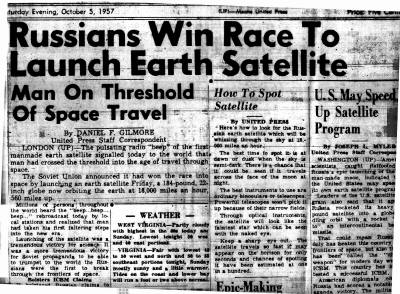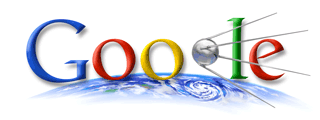Sputnik

Of course the launch of Sputnik I in 1957 was a milestone in American history,
and it was a turning point in Homer Hickam's life. Since 2007 is the 50th
anniversary of Sputnik I, we thought we would assemble a few facts.
|
Sputnik I Timeline as It Relates to Coalwood
Interesting Connections between Sputnik and Mining Sergey Pavlovich Korolyov (often spelled Korolev) was the head Soviet rocket engineer and designer during the Space Race between the United States and the Soviet Union in the 1950s and 1960s. For a time, Korolev was imprisoned in a Soviet gulag where he worked (basically as a slave) as a gold miner. (7) (8) In early 1945, Werner Von Braun and his German rocket team hid the most important documents related to their rockets in a mine shaft. After Von Braun's team surrendered to the Americans, the documents were recovered and transported to the United States where they played a vital role in America's space program. (9)
Sputnik Article from NASA (10) Sputnik 1
Trivia The show Leave It To Beaver made its television debut the evening of October 4, 1957, the same day Sputnik 1 was launched!
References (1) Paul Dickson, Sputnik: The Shock of the Century, G.K.
Hall & Co., Waterville, Maine, 2001, p. 193, Large Print Edition. Photo of Sputnik: NASA: http://nssdc.gsfc.nasa.gov/database/MasterCatalog?sc=1957-001B By the way, Homer, the Rocket Boys, and Coalwood are mentioned in |

This is part of the front page of the Welch Daily News from Saturday
Evening, October 5, 1957, the day after Sputnik I was launched. We would
like to thank Eleanor Beckner from the McDowell Public Library for searching
through the library's archives and providing us with this image. Actually,
Eleanor provided us with the entire front page of that issue. We have
typed all of the articles below to make them easier to read. Thanks,
Eleanor!
|
Man on Threshold By Daniel F. Gilmore LONDON (UP) – The pulsating radio “beep” of the first manmade earth
satellite signaled today to the world that man had crossed the threshold
into the age of travel through space. Bolsters ICBM Claims It bolstered Russian claims to be the first to have perfected an
intercontinental ballistic missile for it might well have taken such a
missile to launch the satellite on its flight around the world every 95
minutes – about 15 times a day. |
|
–Weather– West Virginia – Partly cloudy with highest in the 60s today and Sunday.
Lowest tonight 50 west and 40 east portions. |
|
Must Catch Up DENVER (UPI) – Rocket scientist Harry Stine said Friday night that
United States must catch up with the Russians in rocketry quickly or
“we’re dead.” |
|
How To Spot Satellite Here’s how to look for the Russian earth satellite which will be
whizzing through the sky at 18,000 miles an hour. |
|
Epic-Making WASHINGTON (UP) – a voice behind the frosted-glass door said: “They’ve
done it ... and nothing like it can ever happen again!” |
|
U.S. May Speed By Joseph L. Myler WASHINGTON (UP) – American scientists, caught flatfooted by Russia’s
epic launching of the first man-made moon, indicated today the United
States may speed up its own earth satellite program. No Presidential Comment President Eisenhower, who first announced plans for the U.S. earth
satellite program July 29, 1955, was informed at his Gettysburg, Pa., farm
of the notable Soviet “feat.” He had no immediate comment. Reds Kept Silent Both the U.S. and USSR undertook to send instrument-laden moons into
space as part of the International Geophysical Year (IGY), a cooperative
venture of 64 countries and some 10,000 scientists to strip away mysteries
still veiling the earth. |
Eleanor also sent this clipping from the Welch Daily News, October 14, 1957, page 9.
|
West Virginian Cameron, W. Va. (UP) Two residents of this small Marshall County community have laid claim to being the first in West Virginia to see the Russian satellite, Sputnik. Russell Mathews and a son, Mayes, 14, were trying out a pellet gun near here Sunday when they noticed a "spec" in the sky. Mathews said he sighted along the barrel of the gun and followed the large "spec" for about 30 seconds, or until it was no longer visible. He also pointed out the object to his son. The man said he was not sure whether the object may have been the satellite or its rocket. A short conference at home resulted in another visit where the shiny object had been seen. About 96 minutes later, the time it takes for the satellite or its rocket to circle the earth, the pair saw the "spec" again, Matthews said. But this time, he said, the spec was "not as clear, though still visible to the naked eye." |

